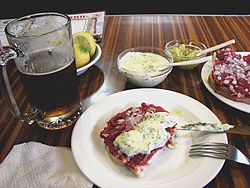This article needs additional citations for verification .(May 2025) |
Deutsch-Chilenen ·Germanochilenos | |
|---|---|
| Total population | |
| around 500,000 [1] | |
| Regions with significant populations | |
| Valdivia, Valparaíso, Santiago, Temuco, Talca, Concepción, Viña del Mar, Osorno, Puerto Octay, Puerto Varas, Villarrica. | |
| Languages | |
| Spanish German Hunsrik Lagunen Deutsch | |
| Religion | |
| Roman Catholic (majority) Lutheran (minority) Judaism Irreligion | |
| Related ethnic groups | |
| Germans, German Americans, German-Argentinians, German-Brazilian, German Canadians, German Mexican, German-Paraguayan, German-Peruvians, German Uruguayans, German Venezuelans, German Australians, German New Zealanders |
German Chileans (Spanish : germanochilenos; German : Deutsch-Chilenen) are Chileans descended from German immigrants, about 30,000 of whom arrived in Chile between 1846 and 1914. Most of these were from traditionally Catholic Bavaria, Baden and the Rhineland, and also from Bohemia in the present-day Czech Republic; even included were Alsatians and Poles through Partitions of Poland. A smaller number of Lutherans immigrated to Chile following the failed revolutions of 1848. [2] [3] [4]
Contents
- History
- Germans in the Spanish Empire
- 19th century
- 20th century
- The terminology “German-Chileans” and “Chilean-Germans”
- German Chileans today
- Education
- Notable German Chileans
- First generation immigrants
- Religious affiliations
- See also
- References
- External links
From the middle of the 19th century to the present, they have played a significant role in the economic, political and cultural development of the Chilean nation. The 19th-century immigrants settled chiefly in Chile's Araucanía, Los Ríos and Los Lagos regions in the so-called Zona Sur of Chile, including the Chilean lake district.






